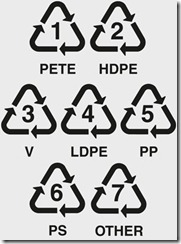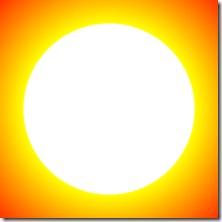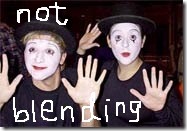No matter how eco-conscious we are, it is challenging to get away from using plastic. Manufacturers use resin ID codes to help us with recycling making it easy to sort our household garbage. Did you know that these numbers can also help us determine the safer plastics and which ones we should try to avoid? I tend to put more thought to the food/products I buy and less attention to the packaging involved. Now I am starting to reconsider after reading about the differences. Here is some information about the most commonly used plastics.
Safer
#1 Polyethylene Terephthalate (PET or PETE)
You will find it in water bottles, shampoo and pop bottles. This might be the most commonly recycled plastic.
#2 High-Density Polyethylene (HDPE)
Most commonly found in cleaning product bottles, milk jugs, some water bottles, saline, medicine bottles and shopping bags.
#4 Low-Density Polyethylene (LDPE)
Found in sandwich bags, some newer plastic wraps, grocery bags. This plastic is not as toxic to manufacture as other plastics, but it is not as commonly recycled.
Questionable
#5 Polypropylene (PP)
Yogurt containers and a variety of food and beverage containers. More studies are needed since research is unclear about chemical leaching. Researchers are unsure if the chemicals/substances pose a health threat.
Try to Avoid
#3 Polyvinyl Chloride (V or PVC)
According to Greenpeace – this plastic ranks as one of the biggest environmental bad guys. PVC (also known as vinyl) contains vinyl chloride, a known human carcinogen. It is most commonly used in construction (PVC pipes in our homes) Found in some plastic wraps, cooking oil bottles and unfortunately many children’s toys. It is rarely recycled but plastic manufacturers still stand by its safety. Apparently many plastic wrapped foods like meats and cheeses in the grocery store are wrapped in polyvinyl chloride (PVC).
#6 Plystyrene (PS) Styrofoam
It is not commonly recycled. It contains benzene which is a suspected carcinogenic. Avoid consuming hot liquids, fatty foods or alcoholic drinks from Styrofoam containers since they may increase leaching. Transfer foods from Styrofoam containers to glass or ceramic as soon as possible.
#7 Other (often polycarbonate made with BPA)
This number covers any other plastic other than #1-6. This mixed bag is concerning since there is conflicting data about this plastic. Often marketed as “non-leaching” and sold as a good green alternative, it is often made using a highly toxic chlorine gas derivative and carcinogenic solvents. The data is conflicting about leaching of bisphenol A. Industry says even low doses would not be enough to hurt you, others suggest that even small amounts this hormone-disrupting chemical can be harmful. Found in microwavable plastics, eating utensils, linings for canned goods and beverage containers, sometimes baby bottles.
Eliminating all plastic packaging from our homes would be an extremely difficult task. Studies suggest that when plastics come in contact with food, certain chemicals migrate and may cause an array of health problems. Try to store food in glass or ceramic and transfer food out of plastic containers before reheating in the microwave.
I used to assume that all recyclable plastic was the same. After reading more about the number codes and what they represent, I am giving more thought to the type of plastics and the products I buy and bring into our home.










